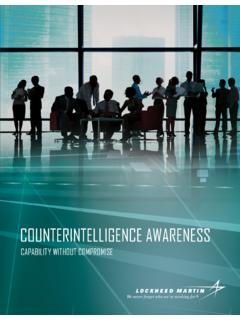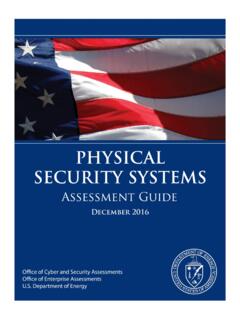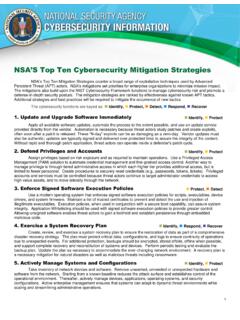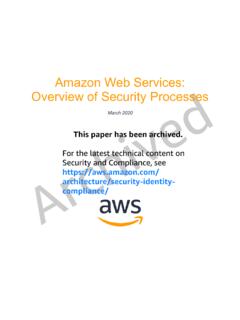Transcription of Intelligence-Driven Computer Network Defense Informed by ...
1 Intelligence-Driven Computer Network Defense Informed by Analysis of Adversary Campaigns and intrusion Kill Chains Eric M. Hutchins , Michael J. Cloppert , Rohan M. Amin, . Lockheed Martin Corporation Abstract Conventional Network Defense tools such as intrusion detection systems and anti-virus focus on the vulnerability component of risk, and traditional incident response methodology presupposes a successful intrusion . An evolution in the goals and sophistication of Computer Network intrusions has rendered these approaches insufficient for certain actors. A new class of threats, appropriately dubbed the Advanced Persistent Threat (APT), represents well-resourced and trained adversaries that conduct multi-year intrusion campaigns targeting highly sensitive economic, proprietary, or national security information . These adversaries accomplish their goals using advanced tools and techniques designed to defeat most conventional Computer Network Defense mechanisms.
2 Network Defense techniques which leverage knowledge about these adversaries can create an intelligence feedback loop, enabling defenders to establish a state of information superiority which decreases the adversary's likelihood of success with each subsequent intrusion attempt. Using a kill chain model to describe phases of intrusions, mapping adversary kill chain indicators to defender courses of action, identifying patterns that link individual intrusions into broader campaigns, and understanding the iterative nature of intelligence gathering form the basis of Intelligence-Driven Computer Network Defense (CND). Institutionalization of this approach reduces the likelihood of adversary success, informs Network Defense investment and resource prioritization, and yields relevant metrics of performance and effectiveness. The evolution of advanced persistent threats necessitates an intelligence-based model because in this model the defenders mitigate not just vulnerability, but the threat component of risk, too.
3 Keywords: incident response, intrusion detection, intelligence, threat, APT, Computer Network Defense 1 Introduction As long as global Computer networks have existed, so have malicious users intent on exploiting vulnerabil- ities. Early evolutions of threats to Computer networks involved self-propagating code. Advancements over time in anti-virus technology significantly reduced this automated risk. More recently, a new class of threats, intent on the compromise of data for economic or military advancement, emerged as the largest element of risk facing some industries. This class of threat has been given the moniker Advanced Persistent Threat, or APT. To date, most organizations have relied on the technologies and processes implemented to mitigate risks associated with automated viruses and worms which do not sufficiently address focused, manually operated APT intrusions. Conventional incident response methods fail to mitigate the risk posed by APTs because they make two flawed assumptions: response should happen after the point of compromise, and the compromise was the result of a fixable flaw (Mitropoulos et al.)
4 , 2006; National Institute of Standards and Technology, 2008). APTs have recently been observed and characterized by both industry and the government. In June and July 2005, the National Infrastructure security Co-ordination Centre (UK-NISCC) and the 1. Computer Emergency Response Team (US-CERT) issued technical alert bulletins describing targeted, socially-engineered emails dropping trojans to exfiltrate sensitive information . These intrusions were over a significant period of time, evaded conventional firewall and anti-virus capabilities, and enabled adversaries to harvest sensitive information (UK-NISCC, 2005; US-CERT, 2005). Epstein and Elgin (2008) of Business Week described numerous intrusions into NASA and other government networks where APT actors were undetected and successful in removing sensitive high-performance rocket design information . In February 2010, iSec Partners noted that current approaches such as anti-virus and patching are not sufficient, end users are directly targeted, and threat actors are after sensitive intellectual property (Stamos, 2010).
5 Before the House Armed Services Committee Subcommittee on Terrorism, Unconventional Threats and Capabilities, James Andrew Lewis of the Center for Strategic and International Studies testified that intrusions occurred at various government agencies in 2007, including the Department of Defense , State Department and Commerce Department, with the intention of information collection (Lewis, 2008). With specificity about the nature of Computer Network operations reportedly emanating from China, the 2008 and 2009 reports to Congress of the Economic and security Review Commission summarized reporting of targeted intrusions against military, government and contractor systems. Again, adversaries were motivated by a desire to collect sensitive information ( Economic and security Review Commission, 2008, 2009). Finally, a report prepared for the Economic and security Review Commission, Krekel (2009) profiles an advanced intrusion with extensive detail demonstrating the patience and calculated nature of APT.
6 Advances in infrastructure management tools have enabled best practices of enterprise-wide patching and hardening, reducing the most easily accessible vulnerabilities in networked services. Yet APT actors continually demonstrate the capability to compromise systems by using advanced tools, customized malware, and zero-day exploits that anti-virus and patching cannot detect or mitigate. Responses to APT intrusions require an evolution in analysis, process, and technology; it is possible to anticipate and mitigate future intrusions based on knowledge of the threat. This paper describes an Intelligence-Driven , threat-focused approach to study intrusions from the adversaries' perspective. Each discrete phase of the intrusion is mapped to courses of action for detection, mitigation and response. The phrase kill chain . describes the structure of the intrusion , and the corresponding model guides analysis to inform actionable security intelligence.
7 Through this model, defenders can develop resilient mitigations against intruders and intelligently prioritize investments in new technology or processes. Kill chain analysis illustrates that the adversary must progress successfully through each stage of the chain before it can achieve its desired objective; just one mitigation disrupts the chain and the adversary. Through Intelligence-Driven response, the defender can achieve an advantage over the aggressor for APT caliber adversaries. This paper is organized as follows: section two of this paper documents related work on phase based models of Defense and countermeasure strategy. Section three introduces an Intelligence-Driven Computer Network Defense model (CND) that incorporates threat-specific intrusion analysis and defensive mitigations. Section four presents an application of this new model to a real case study, and section five summarizes the paper and presents some thoughts on future study.
8 2 Related Work While the modeling of APTs and corresponding response using kill chains is unique, other phase based models to defensive and countermeasure strategies exist. A United States Department of Defense Joint Staff publication describes a kill chain with stages find, fix, track, target, engage, and assess ( Department of Defense , 2007). The United States Air Force (USAF) has used this framework to identify gaps in Intelligence, Surveillance and Reconnaissance (ISR). capability and to prioritize the development of needed systems (Tirpak, 2000). Threat chains have also been used to model Improvised Explosive Device (IED) attacks (National Research Council, 2007). The IED delivery chain models everything from adversary funding to attack execution. Coordinated intelligence and defensive efforts focused on each stage of the IED threat chain as the ideal way to counter these attacks. This approach also provides a model for identification of basic research needs by mapping existing capability to the chain.
9 Phase based models have also been used for antiterrorism planning. The United States Army describes the terrorist operational planning cycle as a seven step process that serves as a baseline to assess the intent and capability of terrorist organizations (United States Army Training 2. and Doctrine Command, 2007). Hayes (2008) applies this model to the antiterrorism planning process for military installations and identifies principles to help commanders determine the best ways to protect themselves. Outside of military context, phase based models have also been used in the information security field. Sakuraba et al. (2008) describe the Attack-Based Sequential Analysis of Countermeasures (ABSAC). framework that aligns types of countermeasures along the time phase of an attack. The ABSAC approach includes more reactive post-compromise countermeasures than early detection capability to uncover persistent adversary campaigns. In an application of phase based models to insider threats, Duran et al.
10 (2009) describe a tiered detection and countermeasure strategy based on the progress of malicious insiders. Willison and Siponen (2009) also address insider threat by adapting a phase based model called Situational Crime Prevention (SCP). SCP models crime from the offender's perspective and then maps controls to various phases of the crime. Finally, the security company Mandiant proposes an exploitation life cycle . The Mandiant model, however, does not map courses of defensive action and is based on post-compromise actions (Mandiant, 2010). Moving detections and mitigations to earlier phases of the intrusion kill chain is essential for CND against APT actors. 3 Intelligence-Driven Computer Network Defense Intelligence-Driven Computer Network Defense is a risk management strategy that addresses the threat component of risk, incorporating analysis of adversaries, their capabilities, objectives, doctrine and limitations. This is necessarily a continuous process, leveraging indicators to discover new activity with yet more indicators to leverage.

















